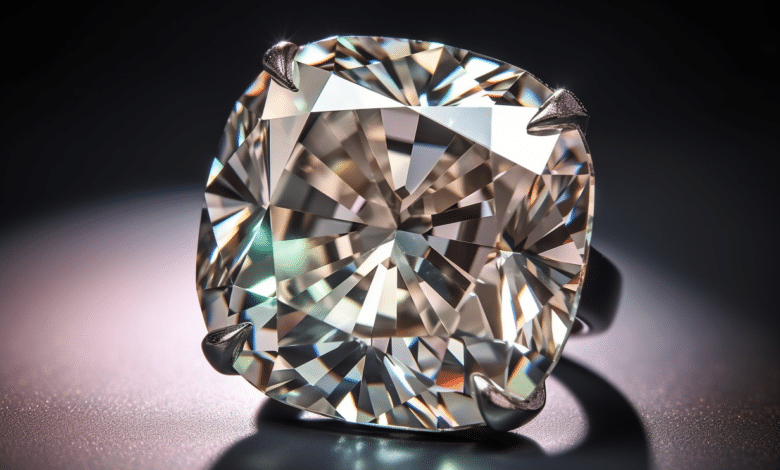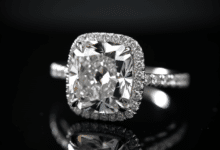The Shocking Truth About Cushion Cut Diamond Prices

Cushion cut diamonds are incredibly popular for their mesmerizing brilliance and unique antique appeal. However, one aspect that often leaves buyers perplexed is the pricing of these exquisite gems. The truth is, cushion cut diamond prices can vary significantly, influenced by a myriad of factors. In this comprehensive guide, we’ll unravel the mysteries behind cushion cut diamond pricing, shedding light on carat size costs and the intricate diamond value factors that shape their coveted worth.


1. The Alluring Charm of Cushion Cut Diamonds
Before delving into the intricacies of pricing, let’s appreciate the captivating allure of cushion cut diamonds. These diamonds boast a distinctive square or rectangular shape with gently rounded corners, lending them a timeless and romantic charm. Originally popularized in the 19th century, cushion cut diamonds have experienced a resurgence in recent years, gracing the fingers of style icons and celebrities alike.
- Their unique shape combines elements of brilliance and fire, creating a dazzling display of light and sparkle.
- Cushion cut diamonds offer a vintage aesthetic that seamlessly blends with modern or antique settings.
- The soft, rounded corners lend a warm and inviting presence to these diamonds, making them a beloved choice for engagement rings and other cherished jewelry pieces.
2. Carat Size and Its Impact on Cost
One of the primary determinants of cushion cut diamond prices is carat size. The larger the diamond, the rarer and more valuable it becomes. However, it’s essential to understand that carat weight is not the sole factor influencing cost. The relationship between carat size and price is non-linear, meaning a diamond’s price doesn’t simply double when its carat weight doubles.
- As the carat size increases, the price per carat tends to rise exponentially, reflecting the diamond’s rarity and desirability.
- For example, a 1-carat cushion cut diamond may cost significantly less per carat than a 2-carat stone of the same quality.
- Larger cushion cut diamonds, especially those above 2 carats, can command premium prices due to their scarcity and the exceptional craftsmanship required to cut and polish them.
3. The Profound Impact of the Four C’s
Beyond carat size, the four C’s – cut, color, clarity, and carat weight – play a profound role in determining the value of cushion cut diamonds. These factors are the universal standard for assessing diamond quality and directly influence pricing.
- Cut: The cut of a cushion cut diamond refers to its proportions, symmetry, and ability to maximize light reflection and brilliance. A well-cut cushion diamond with optimal proportions can command a higher price due to its superior optical performance.
- Color: Cushion cut diamonds are available in various color grades, ranging from the rarest and most valuable D (colorless) to warmer tones like K, L, and M. The closer a diamond is to colorless, the higher its value and price.
- Clarity: This factor refers to the presence or absence of internal inclusions or external blemishes in a diamond. Cushion cut diamonds with higher clarity grades, such as IF (Internally Flawless) or VVS (Very, Very Slightly Included), command premium prices due to their exceptional purity.
- Carat Weight: While carat size is a significant factor, carat weight also plays a role in determining a cushion cut diamond’s value. Diamonds are priced based on their total carat weight, with larger stones typically commanding higher prices per carat.
4. The Influence of Certification and Origin
Reputable diamond certification agencies, such as the Gemological Institute of America (GIA) or the American Gem Society (AGS), play a crucial role in cushion cut diamond pricing. Certified diamonds come with a detailed report outlining their unique characteristics, ensuring transparency and providing buyers with valuable information for making informed decisions.
- Certified cushion cut diamonds generally command higher prices than their uncertified counterparts due to the added assurance of quality and authenticity.
- The origin or source of a cushion cut diamond can also impact its pricing. Diamonds from renowned mining regions, such as Canada, Russia, or Australia, may carry a premium due to their prestige and rarity.
- Ethical and sustainable sourcing practices have also become increasingly important, with consumers willing to pay more for cushion cut diamonds that are conflict-free and environmentally responsible.
5. The Role of Market Demand and Supply
Like any commodity, cushion cut diamond prices are influenced by the interplay of market demand and supply. When demand for cushion cut diamonds surges, as seen during certain fashion trends or cultural movements, prices tend to rise accordingly. Conversely, an oversupply of these diamonds can lead to a decrease in prices.
- Cushion cut diamonds have enjoyed a resurgence in popularity in recent years, driven by their vintage charm and the preference for unique, non-traditional diamond shapes.
- Limited availability of high-quality, larger cushion cut diamonds can drive prices upward due to the scarcity factor.
- Diamond mining and production levels, as well as global economic conditions, can impact the supply and, consequently, the pricing of cushion cut diamonds.
6. The Role of Expert Jewelers and Gemologists
When it comes to understanding the intricacies of cushion cut diamond pricing, the expertise of professional jewelers and gemologists cannot be overstated. These industry professionals possess a wealth of knowledge and experience, enabling them to accurately assess and value cushion cut diamonds based on their unique characteristics and market trends.
- Expert jewelers can guide buyers through the complexities of cushion cut diamond pricing, ensuring they make informed decisions aligned with their preferences and budget.
- Gemologists play a vital role in certifying and grading cushion cut diamonds, providing unbiased assessments that contribute to fair and transparent pricing.
- Reputable jewelers and gemologists can also offer insights into the ethical sourcing and sustainability practices associated with cushion cut diamonds, empowering buyers to make responsible choices.
In conclusion, the shocking truth about cushion cut diamond prices lies in the intricate interplay of various factors, from carat size and the four C’s to certification, origin, and market dynamics. By understanding these nuances, buyers can navigate the world of cushion cut diamonds with confidence, making informed decisions that align with their preferences, budget, and values. Ultimately, the allure of these timeless gems lies not only in their dazzling beauty but also in the stories and craftsmanship behind each exceptional cushion cut diamond.


FAQ: Cushion Cut Diamond Prices
Question 1: How much does a 1-carat cushion cut diamond typically cost?
Answer 1: The price of a 1-carat cushion cut diamond can vary significantly based on its quality factors. On average, you can expect to pay between $2,800 to $5,000 for a 1-carat cushion cut diamond. However, for a more precise estimate, you’d need to consider the specific grades of the diamond. For instance, a 1-carat cushion cut diamond with G color, VS clarity, and VG cut might cost around $3,500. To get an in-depth analysis of this diamond cushion cut’s value, it’s essential to examine all the 4Cs (cut, color, clarity, and carat weight) in detail.
Question 2: Are cushion cut diamonds more expensive than round brilliant cut diamonds?
Answer 2: Generally, cushion cut diamonds are less expensive than round brilliant cut diamonds of comparable carat weight and quality. This price difference can be as much as 25% less for cushion cuts. The main reason for this is that cushion cuts have a higher yield from the rough diamond, meaning less of the original stone is lost during the cutting process. Additionally, round brilliants are in higher demand, which drives up their price. However, it’s important to note that factors like color, clarity, and the specific proportions of the cushion cut can influence the final price.
Question 3: How does the price of a cushion cut diamond change with increasing carat weight?
Answer 3: The price of cushion cut diamonds increases exponentially with carat weight. For example:
A 0.5-carat cushion cut diamond might cost $700-$1,000
A 1-carat cushion cut could range from $2,800-$5,000
A 2-carat cushion cut might be priced between $8,000-$20,000
A 3-carat cushion cut could cost $25,000-$50,000 or more
These prices can vary widely based on the diamond’s specific qualities. For a diamond caratgcolorvsclarityvgcutget an in-depth analysis to understand its true value, as larger diamonds with high-quality grades can command premium prices.
Question 4: How do color and clarity affect the price of a cushion cut diamond?
Answer 4: Color and clarity significantly impact the price of a cushion cut diamond. For color, cushion cuts tend to retain color more than other shapes, so it’s often recommended to choose H color or better for a white appearance. As you move up the color scale (from J to D), the price increases. For clarity, cushion cuts can hide inclusions well, so you can often go lower on the clarity scale without visible imperfections. A VS2 clarity is often a good balance of quality and value. However, moving up the clarity scale (from SI1 to FL) will increase the price substantially. For example, a 1-carat cushion cut with G color and VS2 clarity might cost around $4,000, while the same carat weight with D color and VVS1 clarity could be priced at $8,000 or more.
Question 5: Are elongated cushion cut diamonds more expensive than square cushion cuts?
Answer 5: Contrary to what some might expect, elongated cushion cut diamonds are often slightly less expensive than square cushion cuts of the same carat weight and quality. This is primarily due to market demand, as square cushion cuts are generally more popular. The price difference is usually around 5-10%. For instance, if a 1-carat square cushion cut diamond with certain specifications costs $4,000, a similar elongated cushion cut might be priced at $3,800. However, it’s important to note that personal preference should guide your choice more than this small price difference. A depth analysis of this diamond shape preference can help you decide which style suits you best.
Question 6: How do lab-grown cushion cut diamonds compare in price to natural cushion cut diamonds?
Answer 6: Lab-grown cushion cut diamonds are significantly less expensive than their natural counterparts, often costing 50-70% less. For example, a 1-carat natural cushion cut diamond with G color and VS1 clarity might cost around $4,500, while a lab-grown diamond with the same specifications could be priced at $1,800-$2,200. The price difference becomes even more pronounced with larger carat weights. However, it’s crucial to understand that lab-grown diamonds, while chemically and physically identical to natural diamonds, may not retain value in the same way over time. When considering a lab-grown cushion cut diamond, it’s advisable to get an in-depth analysis of the diamond’s quality factors, as these can vary just as they do with natural diamonds.












